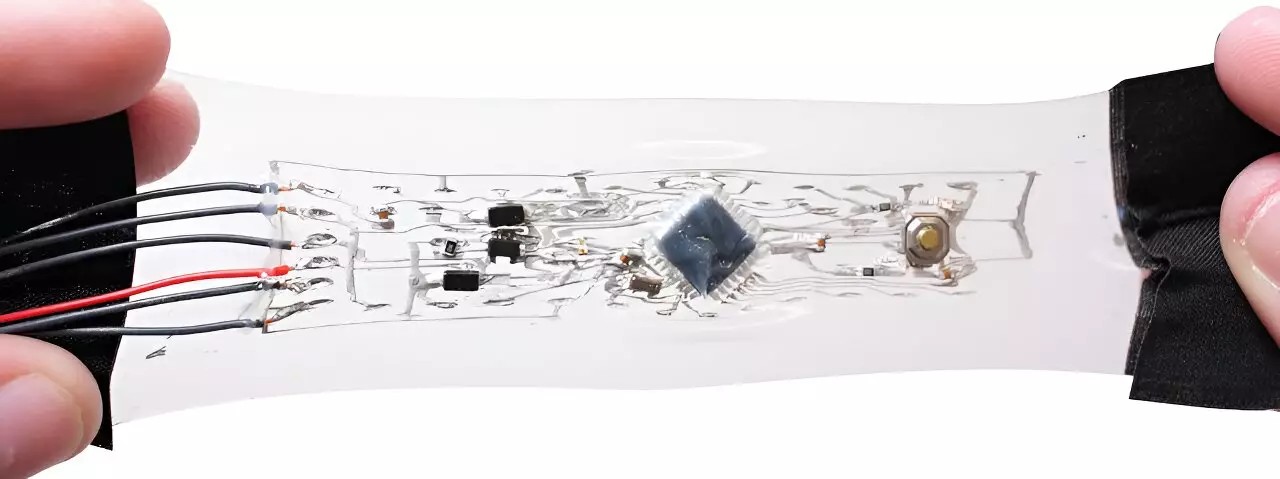In recent years, the realm of soft robotics and wearable electronic devices has garnered immense attention due to its potential applications across various fields, including search-and-rescue operations and orthopedic rehabilitation. Despite this promise, the journey toward creating functional and practical devices has been riddled with challenges. Researchers, however, are making significant strides in addressing these issues, with groundbreaking work emerging from the lab of Professor Rebecca Kramer-Bottiglio. Her team’s recent advancements in stretchable electronics hold the potential to revolutionize the interaction between soft and rigid components within robotic designs.
The fundamental challenge that persists in soft robotics lies in the integration of soft materials with the rigid circuitry typically used in traditional designs. In many instances, the circuitry is separate from the soft robots, often attached to external circuit boards. This separation inhibits the devices from reaching their full functional capabilities. As designers work to insulate these rigid components from the strain experienced by soft materials, a compromise is often reached: functionality is sacrificed for the sake of flexibility. However, this compromises the robots’ efficiencies, limiting them to basic operations that fail to tap into the true potential of soft robotic technology.
In a paradigm shift, Kramer-Bottiglio’s research team has developed a solution through the creation of stretchable electronics inspired by Arduino technology. By embedding these advanced circuits into soft robots, they have managed to bridge the gap between rigidity and flexibility. Their most notable achievement is the successful demonstration of a complex circuit capable of stretching significantly beyond its original form—extending up to three to four times its initial size. This method not only allows for better integration within soft robotic structures but also enhances the overall computing power without compromising stretchability.
The researchers have gone beyond creating mere prototypes; they have ushered in an era of scalable and reproducible stretchable electronics. With over 70 contact points flexibly integrating rigid and soft components in testing, their efforts mark a monumental transition from simplistic designs to more intricate and reliable multilayer circuits. The implications of this innovation extend to numerous applications, paving the way for more versatile and robust robotic systems.
One of the significant highlights of Kramer-Bottiglio’s work is the focus on accessibility and versatility. By demonstrating the practicality of their system on various widely-used platforms like the Arduino Pro Mini and Lilypad, alongside additional components like gesture sensors, the researchers have opened doors for a diverse range of applications. Importantly, the researchers have made their manufacturing processes and designs openly available, democratizing technology for aspiring engineers and researchers. By eliminating barriers to entry such as the need for specialized tools, materials, or extensive technical know-how, they have set the stage for widespread innovation in the field.
The fabrication process relies on innovative use of gallium-based liquid metal, which, through exposure to oxygen, can be transformed into a patternable paste. This not only simplifies the circuit design process but also allows for strong adhesion to both soft and rigid substrates. The practical design ensures that users can easily apply these electronic circuits to integrate their functionalities seamlessly into soft robots.
The research team has already begun exploring various applications of their stretchable electronics in real-world robotic designs. One notable example includes embedding the circuit into a quadrupedal robot, facilitating its movement dynamics while maintaining structural integrity during stretching. Furthermore, the potential for wearable devices is equally promising. The researchers showcased the application of stretchable electronics on an elbow joint, historically a challenging area due to the extensive range of motion involved. The successful implementation underscores the capability of these advanced circuits in medical devices that assist with rehabilitation or injury support.
As the field of soft robotics continues to grow, these innovative stretchable electronics hold the promise of transforming how robotic systems operate and interact with their environments. The fundamental work by Professor Kramer-Bottiglio and her team not only addresses current technological limitations but also offers a glimpse into a future where advanced robotics are seamlessly integrated into daily life—enhancing both functionality and user adaptability. This ongoing evolution signals a pivotal moment in the maturation of robotics technology, hinting at a more interconnected and responsive future.

